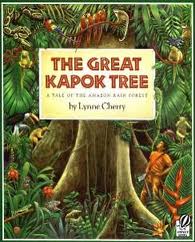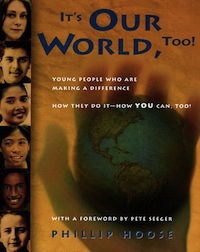The Great Kapok Tree: A Tale of the Amazon Rain Forest

by Lynne Cherry. ![]() Picture Book. 40 pages. Grades K-2.
Picture Book. 40 pages. Grades K-2.
Find this book: Amazon

Teacher's Guide

This lushly illustrated book is a plea for the rainforests of the earth. The green foliage of the equatorial jungle covers the pages and hides some of the creatures who become spokesmen for the forest. Two men approach a huge kapok tree and the larger man commands the smaller one to cut it down and then departs. Cutting a kapok tree of that size is no easy task and the man soon tires and falls asleep at the base of the tree. One by one the animals approach him and whisper reasons for letting the tree live into his ear as he sleeps. Wakening he sees the creatures, including a human child, clustered around him. They fall silent, letting his own senses do the communicating now, and he drops his ax and walks away.
The message is far from subtle, but it is nicely done here and easily understood by even the youngest reader and listener.
(Continued Below)
Advertisement:

Things to Talk About and Notice
- First of all there is the cover. What's happening here? A man with an ax eyes the great tree with animals looking on. What might each be thinking? The title tree bears some talking about.
- Who is Lynne Cherry? Read about her on the back end flap. She visited the rain forest. Why did she write and illustrate the book? Could she have done it without visiting there? What would she know first hand that she might not have gotten otherwise?
- Look at the acknowledgements on the reverse of the title page. The author thanks many people including Carlos Miller who served as a model of the woodcutter. Speculate on why she chose him. Was he a woodcutter, do you think or did he just look the part?
- Notice the sequence of animals that speak to the woodcutter. Which layers do they come from? Each gives a different reason for saving the tree: some are altruistic and others are selfish. Where do you think the larger man went? Are other trees being cut down while the woodcutter sleeps?
- When the jaguar appears, it says, "Because his spotted coat blended into the dappled light and shadows of the understory, no one had noticed him." Did you? He's on two previous pages. Can you find him?

Activities
- Youngsters may have heard of kapok fillings in various sports equipment and sleeping bags. Do we need to cut down trees in order to have things? What things? Make a list.
- Open the cover. Notice the endpapers which show a world map with rainforest areas shown in green. Notice where the rainforests are. Are rainforests and jungles the same thing? How are they different from forests? An inset shows the layers of the rainforest with the various animal life found in each layer. Around the edges of the spread are the animals clearly labeled for further examination. Do you think they'll all be in the story? Make a list of them and circle the ones mentioned or shown in the story.
- Notice the dedication on the reverse of the title page. What did Chico Mendes do that cost him his life? Was it foul play? Did his life and death have any other effects besides the writing of this book? Where could you find out?
- After reading the book, there's lots to talk about. The animals give eloquent arguments for saving the tree and they succeed in doing so. All trees are parts of ecosystems. What if no trees were cut? Look around you and list the things that come from trees. Could you live without them? Make the arguments for cutting trees. What if all trees were cut? Make a list of things that would disappear if that happened. What are some solutions?
- Read about the situation in the American northwest where lumbering and conserving are at odds. Present the arguments from both sides. Are trees a renewable resource?
(Continued Below)
Advertisement:

Related Books

 Grades 3 - 9
Grades 3 - 9
It's Our World Too: Young People Who Are Making a Difference: How They Do It--How You Can, Too! by Phillip Hoose. Nonfiction. 176 pages.
Find this book: Local Bookstore, Amazon, B&N
So much of the news of young people in our society is sad that it was fun to read It's Our World Too. I thought by the cover that these were all young adults but the chapter that moved me most was about a class of first and second graders in Sweden who bought a rain forest. The writing is personal, emotional and so skillful that the young people cited here seem real and not too good to be true. Their projects were/are worthwhile, possible to emulate, and inspiring. This is a book to hand to students and teachers who are reading about the environment, the homeless, the handicapped and the disenfranchised and are feeling overwhelmed and hopeless about any and all of these problems. Read More.- Shel Silverstein's The Giving Tree (Harper)
- Natalia Romanova's Once There Was a Tree (Dial, 1989 ISBN 0-8037-0705-3)
- Jeanne Baker's Where the Forest Meets the Sea (Greenwillow, 1988 ISBN 0-688-06364-0)
- Naomi Russell's The Tree (Dutton, 1989 ISBN 0-525-44468-8)
- John Gile's The First Forest (Gile, 1989 ISBN 0-910941-01-7)
(Continued Below)
Advertisement:

Related Areas Within Carol Hurst's Children's Literature Web Site
- Free Teacher's Guides: A listing of all our teacher's guides. Picture Books, Nonfiction and Fiction.

